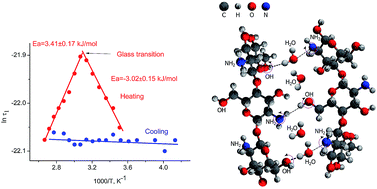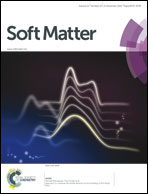Novel gigahertz frequency dielectric relaxations in chitosan films
Abstract
Molecular relaxations of chitosan films have been investigated in the wide frequency range of 0.1 to 3 × 109 Hz from −10 °C to 110 °C using dielectric spectroscopy. For the first time, two high-frequency relaxation processes (in the range 108 to 3 × 109 Hz) are reported in addition to the low frequency relaxations α and β. These two relaxation processes are related to the vibrations of OH and NH2/NH3+, respectively. The high-frequency relaxations exhibit Arrhenius-type dependencies in the temperature range 10 °C to 54 °C with negative activation energy; this observation is traceable to hydrogen bonding reorientation. At temperatures above the glass transition temperature (54 °C), the activation energy changes from negative to positive values due to breaking of hydrogen bonding and water loss. Upon cooling in a sealed environment, the activation energies of two relaxation processes are nearly zero. FTIR and XRD analyses reveal associated structural changes upon heating and cooling. These two new high-frequency relaxation processes can be attributed to the interaction of bound water with OH and NH2/NH3+, respectively. A plausible scenario for these high-frequency relaxations is discussed in light of impedance spectroscopy, TGA, FTIR and XRD measurements.


 Please wait while we load your content...
Please wait while we load your content...